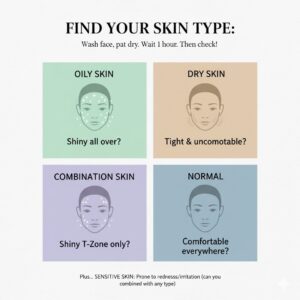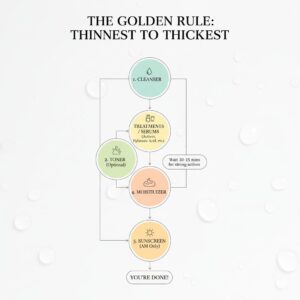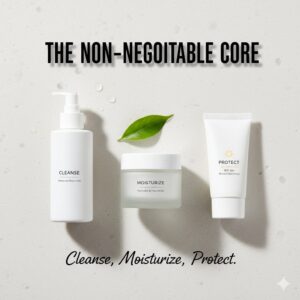How to Build a Skincare Routine:
Walking down the skincare aisle or scrolling through beauty content can feel overwhelming. Ten-step routines, unfamiliar ingredients, conflicting advice—it’s enough to make anyone give up before they even start. But here’s the truth: building an effective skincare routine doesn’t have to be complicated or expensive.
Whether you’re in Karachi dealing with humidity and pollution or anywhere else in the world, the fundamentals of good skincare remain the same. You don’t need twenty products or a bathroom counter that looks like a cosmetic store. What you need is a simple, consistent routine tailored to your skin’s actual needs.
After years of analyzing skincare formulations and seeing what actually works, I’m going to walk you through exactly how to build a routine from scratch—one that’s realistic, effective, and won’t break the bank.
Understanding Your Skin Type First
Before buying a single product, you need to know your skin type. This determines everything else in your routine.

The Five Basic Skin Types
Normal Skin: Balanced, not too oily or dry, minimal concerns. Lucky you—most products will work well.
Oily Skin: Shiny by midday, enlarged pores, prone to blackheads and acne. Common in humid climates like Pakistan’s coastal cities.
Dry Skin: Feels tight, flaky patches, may look dull. More common in dry climates or with age.
Combination Skin: Oily T-zone (forehead, nose, chin) but normal or dry cheeks. Very common skin type globally.
Sensitive Skin: Reacts easily to products, prone to redness, stinging, or irritation. Can occur with any other type.
How to Determine Your Type
Do this simple test: Wash your face with a gentle cleanser, pat dry, and wait one hour without applying anything. Then check:
- Shiny all over? Oily skin
- Tight and uncomfortable? Dry skin
- Shiny T-zone only? Combination skin
- Comfortable everywhere? Normal skin
- Redness or irritation? Sensitive skin (plus another type)
According to the American Academy of Dermatology, knowing your skin type is the foundation of any effective skincare routine—it’s not just marketing hype.
The Non-Negotiable Core: Your Basic Routine
Every single person needs these three steps, regardless of skin type. This is your foundation.
Step 1: Cleanser (Morning and Night)
Cleansing removes dirt, oil, pollution, sunscreen, and makeup. It’s the first step to healthy skin.
For oily/acne-prone skin: Use a gentle foaming or gel cleanser. Look for ingredients like salicylic acid (helps with breakouts) or tea tree oil.
For dry/sensitive skin: Use a cream or milk cleanser. Avoid sulfates (SLS/SLES) which can strip your skin.
For combination skin: A gentle gel cleanser works well, or use different cleansers on different areas.
For all skin types in Pakistan: If you wear heavy sunscreen or deal with pollution (especially in Lahore or Karachi), consider double cleansing at night—an oil cleanser first, then your regular cleanser.
How to cleanse properly:
- Wet your face with lukewarm water (not hot!)
- Apply a small amount of cleanser
- Massage gently for 30-60 seconds
- Rinse thoroughly
- Pat dry with a clean towel (don’t rub)
Common mistake: Over-cleansing. If your skin feels tight or “squeaky clean,” your cleanser is too harsh.
Step 2: Moisturizer (Morning and Night)
Every skin type needs moisture—yes, even oily skin. Skipping moisturizer can actually make oily skin produce more oil to compensate.
For oily skin: Choose lightweight, oil-free, or gel-based moisturizers. Look for niacinamide, which helps control oil production.
For dry skin: Choose richer creams with ceramides and hyaluronic acid to lock in moisture.
For combination skin: Use a lightweight moisturizer all over, or apply a richer cream on dry areas and lighter lotion on oily zones.
For sensitive skin: Choose fragrance-free, minimal-ingredient moisturizers. Centella asiatica is excellent for reactive skin.
Application tip: Apply moisturizer to slightly damp skin—this helps seal in hydration.
Step 3: Sunscreen (Every Morning)
This is the single most important anti-aging and skin-protecting step you can take. Sun damage is cumulative and causes:
- Premature aging (wrinkles, sagging)
- Dark spots and hyperpigmentation
- Increased risk of skin cancer
- Breakdown of collagen
What to look for:
- SPF 30 or higher
- Broad spectrum (protects against UVA and UVB)
- Water-resistant if you’ll be outdoors
Types of sunscreen:
Chemical sunscreens: Absorb UV rays. Lighter texture, better for oily skin. Common ingredients: avobenzone, octinoxate.
Physical (mineral) sunscreens: Reflect UV rays. Better for sensitive skin. Ingredients: zinc oxide, titanium dioxide. Can leave a white cast (especially on darker skin tones).
For Pakistani climate: Look for sweat-resistant formulas, especially during summer months.
Application rules:
- Apply as the LAST step in your morning routine
- Use about ½ teaspoon for your face and neck
- Reapply every 2 hours if outdoors
- Apply even on cloudy days (UV rays penetrate clouds)
Research published by the National Institutes of Health shows that daily sunscreen use can reduce signs of aging by up to 24% over just one year.
The Complete Three-Step Routine
Let me make this crystal clear:
MORNING:
- Cleanser
- Moisturizer (on damp skin)
- Sunscreen SPF 30+
EVENING:
- Cleanser (double cleanse if wearing sunscreen/makeup)
- Moisturizer
That’s it. This is all you need to start. Master these three steps for 4-6 weeks before adding anything else.
When to Add Treatment Products (Step 4)
Once your basic routine is solid, you can add targeted treatments based on your concerns.
For Acne and Breakouts
Best ingredients:
- Salicylic acid (BHA): Penetrates pores to clear congestion
- Benzoyl peroxide: Kills acne bacteria
- Niacinamide: Reduces inflammation and oil
When to apply: After cleansing, before moisturizer
Frequency: Start 2-3 times per week, increase as tolerated
Product types: Toners, serums, or spot treatments
For Dark Spots and Hyperpigmentation
Best ingredients:
- Vitamin C: Brightens and prevents new spots
- Alpha hydroxy acids (AHAs): Exfoliate to fade marks
- Niacinamide: Reduces melanin transfer
- Azelaic acid: Works on existing pigmentation
When to apply: Vitamin C in the morning, AHAs at night
Frequency: Daily for vitamin C, 2-4 times weekly for AHAs
Important for darker skin tones: Be patient and consistent. Avoid aggressive treatments that can cause post-inflammatory hyperpigmentation (PIH).
For Aging and Wrinkles
Best ingredients:
- Retinol: The gold standard for anti-aging
- Peptides: Support collagen production
- Vitamin C: Antioxidant protection and collagen boost
When to apply: Retinol at night only, vitamin C in the morning, peptides anytime
Frequency: Start retinol 1-2 times per week, increase gradually
Age to start: Mid to late 20s for prevention, 30s+ for treatment
For Dryness and Dehydration
Best ingredients:
- Hyaluronic acid: Holds up to 1000x its weight in water
- Glycerin: Draws moisture to skin
- Ceramides: Repairs skin barrier
When to apply: After cleansing, on damp skin, before moisturizer
Frequency: Daily, morning and night
Product types: Essences, serums, or hydrating toners
The Correct Order of Application
This confuses everyone, but there’s a simple rule: Apply products from thinnest to thickest consistency.

Complete Morning Routine (with treatments)
- Cleanser
- Toner (optional, hydrating type)
- Treatment serum (vitamin C, niacinamide, etc.)
- Eye cream (optional)
- Moisturizer
- Sunscreen
Complete Evening Routine (with treatments)
- Oil cleanser (if wearing sunscreen/makeup)
- Water-based cleanser
- Exfoliant (BHA, AHA, 2-4x per week)
- Wait 10-15 minutes if using strong actives
- Treatment serum (retinol, peptides, etc.)
- Eye cream (optional)
- Moisturizer
- Facial oil (optional, for extra dryness)
Wait times: Give active ingredients (retinol, vitamin C, acids) 10-15 minutes to absorb before the next step.
Common Mistakes Beginners Make
Mistake 1: Buying Too Many Products at Once
Start with the basics (cleanser, moisturizer, sunscreen). Add one new product every 2-3 weeks. This way, if something breaks you out, you’ll know exactly what caused it.
Mistake 2: Using Products Incorrectly
Read instructions! Some products work best on damp skin (hyaluronic acid), others need dry skin (retinol). Some need wait times, others don’t.
Mistake 3: Expecting Overnight Results
Skincare takes time. Give any new routine at least 6-8 weeks before deciding if it’s working. Some ingredients (like retinol) take 12 weeks to show full benefits.
Mistake 4: Over-Exfoliating
Using acids or scrubs too often damages your skin barrier. Start with 2-3 times per week maximum. Signs of over-exfoliation: tightness, redness, increased sensitivity, more breakouts.
Mistake 5: Not Patch Testing
Always patch test new products, especially if you have sensitive skin. Apply a small amount behind your ear or on your inner forearm for 24 hours before using on your face.
Mistake 6: Inconsistency
Skincare requires consistency. Using products sporadically won’t give results. Stick to your routine for at least 2 months.
Building a Routine on a Budget
You don’t need expensive products to have great skin. Here’s how to prioritize:
Essential Investments (Don’t Skimp Here)
- Sunscreen: This is your most important product. Find one you’ll actually wear daily.
- Gentle cleanser: Worth spending a bit more for one that doesn’t strip your skin.
Where You Can Save
- Moisturizers: Many affordable options work excellently
- Basic actives: Drugstore brands often have effective retinol and niacinamide
- Toners: Optional—you can skip this entirely if on a tight budget
Local Pakistani Options
Many international brands available in Pakistan offer good quality at reasonable prices. Also explore local brands that formulate for our climate—lighter textures work better in humidity.
Adjusting Your Routine by Season
Your skin’s needs change with the weather, especially in regions with extreme seasonal variation.
Summer/Monsoon (Hot & Humid)
- Use lighter, gel-based moisturizers
- Double cleanse to remove sweat and pollution
- Use oil-control products if needed
- Be extra diligent about sunscreen
- Consider mattifying sunscreens for oily skin
Winter (Cold & Dry)
- Switch to richer, creamier moisturizers
- Add a facial oil if needed
- Reduce exfoliation frequency
- Use a humidifier indoors
- Don’t forget sunscreen (UV rays exist year-round)
Special Considerations for Different Ages
Teens (13-19)
Focus: Acne prevention, sun protection, gentle care Key products: Gentle cleanser, oil-free moisturizer, sunscreen, spot treatments if needed Avoid: Harsh scrubs, too many actives, expensive anti-aging products (you don’t need them yet)
20s
Focus: Prevention, establishing good habits, treating specific concerns Key products: The basic three, plus targeted treatments for acne or pigmentation if needed Consider adding: Vitamin C (mid-20s), gentle retinol (late 20s)
30s
Focus: Early anti-aging, maintaining skin health Key products: The basic three, retinol, vitamin C, peptides Consider adding: Eye cream, more intensive hydration
40s and Beyond
Focus: Addressing established aging signs, supporting skin barrier Key products: The basic three, prescription retinoids if possible, peptides, rich moisturizers Consider adding: Targeted treatments for deeper wrinkles, neck care
When to See a Dermatologist
A good routine helps most skin concerns, but some situations need professional help:
- Severe or cystic acne
- Persistent redness or rosacea
- Sudden changes in your skin
- Suspicious moles or growths
- Conditions that don’t respond to OTC treatments
- Before starting prescription treatments
According to the American Academy of Dermatology, regular skin checks are important for everyone, especially if you have a history of sun exposure or skin cancer in your family.
The Truth About “Natural” and “Clean” Beauty
There’s a lot of marketing around “natural” and “clean” skincare. Here’s what matters:
What actually matters:
- Does it work for your skin?
- Is it properly formulated?
- Does it contain effective concentrations of active ingredients?
- Is it preserved properly to prevent bacterial growth?
What doesn’t matter as much:
- Whether ingredients are “natural” or synthetic
- Fancy packaging or celebrity endorsements
- Whether it’s “chemical-free” (everything is chemicals!)
Both natural and synthetic ingredients can be effective or irritating. Focus on what works for YOUR skin, not marketing buzzwords.
Building Your Personalized Routine: Step-by-Step Action Plan
Ready to start? Here’s your practical action plan:
Week 1-2: The Foundation
Buy and start using:
- Gentle cleanser for your skin type
- Basic moisturizer for your skin type
- Sunscreen SPF 30+ you’ll actually wear
Use these twice daily (sunscreen only AM). Get comfortable with this routine.
Week 3-4: Assess and Adjust
- Is your cleanser too harsh or too weak?
- Is your moisturizer enough or too heavy?
- Are you consistently using sunscreen?
Make adjustments if needed. The goal is finding products that feel good and that you’ll use consistently.
Week 5-6: Add One Treatment (If Needed)
Based on your main concern, add ONE treatment product:
- For acne: Salicylic acid or benzoyl peroxide
- For aging: Retinol (start 1-2x per week)
- For brightness: Vitamin C
- For hydration: Hyaluronic acid serum
Start slowly. Introduce gradually.
Week 7-8: Evaluate
How’s your skin responding? If good, continue. If you’re seeing irritation, reduce frequency or concentration.
Beyond Week 8
Only after 8+ weeks of a consistent basic routine should you consider adding more products. Many people find that a simple routine is all they ever need.
Sample Routines for Different Skin Types
For Oily/Acne-Prone Skin
Morning:
- Foaming cleanser
- Niacinamide serum
- Oil-free moisturizer
- Matte sunscreen
Evening:
- Double cleanse
- Salicylic acid toner (3-4x per week)
- Niacinamide serum
- Lightweight moisturizer
For Dry/Mature Skin
Morning:
- Cream cleanser
- Vitamin C serum
- Hyaluronic acid serum (on damp skin)
- Rich moisturizer
- Sunscreen
Evening:
- Gentle cleanser
- Retinol (3-5x per week)
- Peptide serum
- Rich moisturizer or sleeping mask
- Facial oil (if needed)
For Combination Skin
Morning:
- Gentle gel cleanser
- Hydrating toner
- Lightweight serum (niacinamide or vitamin C)
- Gel-cream moisturizer
- Sunscreen
Evening:
- Double cleanse
- AHA or BHA (2-3x per week, on oily zones)
- Hydrating serum
- Moisturizer (heavier on dry areas, lighter on oily zones)
For Sensitive Skin
Morning:
- Ultra-gentle cleanser
- Centella or soothing serum
- Fragrance-free moisturizer
- Mineral sunscreen
Evening:
- Gentle cleanser or micellar water
- Centella or barrier-repair serum
- Rich, soothing moisturizer
- Minimal actives (introduce very slowly if at all)
The Bottom Line
Building an effective skincare routine doesn’t require complicated 10-step rituals or expensive luxury products. It requires understanding your skin, choosing appropriate products, and—most importantly—using them consistently.
Start with the three basics: cleanse, moisturize, protect. Master those before adding anything else. When you do add treatments, introduce them one at a time and give them at least 6-8 weeks to work.
Remember: the best skincare routine is one you’ll actually stick to. Simple, consistent care beats elaborate routines you abandon after two weeks.
Your skin didn’t develop its current concerns overnight, and it won’t transform overnight either. Be patient, be consistent, and adjust as needed. In a few months, you’ll look back and see real improvement—not from magic potions, but from taking care of your skin properly, day after day.
Start today with just three products. That’s all you need to begin your journey to healthier skin.
Frequently Asked Questions (FAQs)
Q1: How long should I wait between applying different products?
Answer: For most products, 30-60 seconds is enough. However, wait 10-15 minutes after applying strong actives like retinol, vitamin C, or acids before applying the next product. This gives them time to work at their optimal pH. For products like hyaluronic acid, apply immediately to damp skin—don’t wait.
Q2: Can I use the same routine morning and night?
Answer: Your basic cleanse-moisturize routine can be identical, but mornings require sunscreen (never skip!), while evenings are better for active treatments like retinol or acids that increase sun sensitivity. Many people prefer heavier moisturizers at night and lighter ones during the day under makeup.
Q3: How do I know if a product is breaking me out or just purging?
Answer: Purging occurs only with ingredients that increase cell turnover (retinol, AHAs, BHAs) and only in areas where you typically break out. It should improve within 4-6 weeks. If you’re breaking out in new areas, it’s worsening after 6 weeks, or you’re using a product that doesn’t cause purging (like moisturizer), it’s likely a reaction—stop using that product.
Q4: Is it okay to skip skincare some days?
Answer: Consistency is key for results, but life happens. If you must skip, never skip sunscreen during the day or cleansing at night (especially if wearing sunscreen or makeup). Missing a treatment product occasionally won’t ruin your progress, but making skipping a habit will prevent you from seeing results.
Q5: When will I see results from my new routine?
Answer: It depends on the product and concern. Hydration improvements appear within days. Acne treatments show results in 6-8 weeks. Anti-aging actives like retinol need 12+ weeks. Surface improvements (texture, brightness) from acids take 4-6 weeks. Be patient—skincare is a marathon, not a sprint.
Q6: Do I need different products for day and night?
Answer: Not necessarily. Your cleanser and moisturizer can be the same. However, certain ingredients work best at specific times: sunscreen is only for morning, retinol only for night, vitamin C typically morning. Some people prefer lighter products in the morning and richer ones at night, but it’s not required if your single routine works well.


